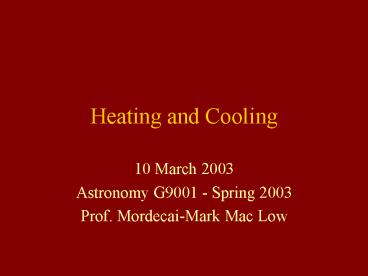Heating and Cooling
1 / 25
Title:
Heating and Cooling
Description:
Grain Photoelectric Heating ... Gas remains isothermal in this regime, ultimately due to cooling of dust grains by IR emission. ... –
Number of Views:52
Avg rating:3.0/5.0
Title: Heating and Cooling
1
Heating and Cooling
- 10 March 2003
- Astronomy G9001 - Spring 2003
- Prof. Mordecai-Mark Mac Low
2
Transparent ISM Mechanisms
Wolfire et al. 1995, Spitzer PPISM
- Heating
- cosmic rays
- photoionization
- UV
- soft X-rays
- grain photoelectric heating
- shock heating
- Cooling
- molecular rotation, vibration
- atomic fine structure, metastable
- resonance lines
- bremsstrahlung
- recombination
- dust emission
3
Cosmic Rays
- H ionization produces primary electrons with ltEgt
35 eV. Counting secondaries, ltEegt3.4 eV. - Field, Goldsmith, Habing took ?CR 4 ? 10-16 s-1
- Observations now suggest ?CR 2 ? 10-17 s-1
- ionization-sensitive molecules (HD, OH, H3)
- short path-lengths of low energy CRs
4
Photoionization Heating
5
X-ray Ionization Heating
- Transfers energy from 106 K gas to gas with T ltlt
104 K, with a small contribution from
extragalactic sources - To calculate local contribution, must take
absorption into account - Can maintain high electron densities even if
heating rate is low.
heat from each primary e-
absorption of X-rays
6
Grain Photoelectric Heating
- Small grains (PAHs, a lt 15Å) can be efficiently
photoionized by FUV (Bakes Thielens 1994). - 10 of flux absorption
- 50 of photoelectron production
7
Efficiency of Grain Heating
grains neutral
grains charged
8
Shock Heating
- Extremely inhomogeneous
- Produces high-pressure regions that interact with
surroundings - Traditionally, included in equilibrium
thermodynamical descriptions anyway
9
Cooling
- Radiative cooling requires available energy
levels for collisional excitation - Cold gas (10 lt T lt 103) excitation of molecular
rotational and vibrational lines and atomic fine
structure lines
10
Diffuse ISM Cooling Curve
T-0.7
Bremsstrahl. T1/2
Gaetz Salpeter 1983
11
Opaque ISM Mechanisms
Hollenbach Tielens 1999, Neufeld et al 1995
- Heating
- interiors
- cosmic rays
- grain heating by visible IR
- edges (PDRs)
- grain PAH UV photoelectric
- H2 pumping by FUV
- Cooling
- gas
- molecular rotation, vibration
- atomic fine structure, metastable
- radiative transfer determines escape of energy
from gas - grains
- grain emission in FIR
- gas-grain coupling
12
Cooling in Opaque gas
- Emission from an optically thick line reaches the
blackbody value - velocity gradients allow escape of radiation
through line wings - many molecular and atomic lines can contribute in
some regimes, but CO, H2, H2O, and O most
important - detailed models of chemistry required to
determine full cooling function
13
Neufeld, Lepp, Melnick 1995
14
- Homonuclear species like H2 do not have low-lying
energy levels - Rarer polar species contribute most to cooling in
10 K gas - Fine structure lines most important at surfaces
of PDRs
15
Isothermal Equation of State
- For densities 10-19 lt ? lt 10-13 cm-3, cooling is
very efficient down to about 10 K - Gas remains isothermal in this regime, ultimately
due to cooling of dust grains by IR emission. - Compressibility is high P ?
- When even dust becomes optically thick, gas
becomes adiabatic, subject to compressional
heating, such as during protostellar collapse.
16
Energy Equation
heating
cooling
17
Thermal Instability
Balbus 1986
18
If tcool increases as T increases, then system
is unstable
19
(Isobaric) Thermal Instability
- Perturb temperature of points along the thermal
equilibrium curve
- Stable if they return to equilibrium
- Unstable if they depart from equilibrium
20
Two-Phase Models
log ? (cm-3)
Wolfire et al 1995
21
Three-Phase Model
- Attempt to extend FGH two-phase model to include
presence of hot gas (McKee Ostriker 1977) - Hot gas not technically stable (no continuous
heating, only intermittent), but has long cooling
timescale (determined by evaporation off of
clouds in MO77 - Pressure fixed by action of local SNR
- Temperature of cold phases fixed by points of
stability on phase diagram as in two-phase model
22
Turbulent Flow
- Equilibrium models only appropriate for
quasi-static situations - If compressions and rarefactions occur on the
cooling timescale, then gas will lie far from
equilibrium - Conversely, rapid cooling or heating can generate
turbulent flows (Kritsuk Norman)
23
MHD Courant Condition
- Similarly, the time step must include the fastest
signal speed in the problem either the flow
velocity v or the fast magnetosonic speed vf2
cs2 vA2
24
Lorentz Forces
- Update pressure term during source step
- Tension term drives Alfvén waves
- Must be updated at same time as induction
equation to ensure correct propagation speeds - operator splitting of two terms
25
Added Routines
Stone Norman 1992b































